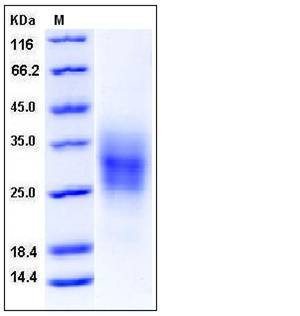Mouse TRAIL R2 / CD262 / TNFRSF10B Protein (His Tag)
DR5,KILLER,Ly98,MK,TRAILR2,TRICK2A,TRICK2B,TRICKB
- 100ug (NPP3520) Please inquiry
| Catalog Number | P50412-M08H |
|---|---|
| Organism Species | Mouse |
| Host | Human Cells |
| Synonyms | DR5,KILLER,Ly98,MK,TRAILR2,TRICK2A,TRICK2B,TRICKB |
| Molecular Weight | The secreted recombinant mouse TNFRSF10B consists of 136 amino acids and has a calculated molecular mass of 15 kDa. As a result of glycosylation, the apparent molecular mass of the recombinant protein is approximately 25-35 kDa in SDS-PAGE under reducing conditions. |
| predicted N | Asn 53 |
| SDS-PAGE |  |
| Purity | > 95 % as determined by SDS-PAGE |
| Protein Construction | A DNA sequence encoding the extracellular domain of mouse TNFRSF10B (NP_064671.2) (Met 1-Ser 177) was expressed, with a C-terminal polyhistidine tag. |
| Bio-activity | 1. Immobilized mouse TNFRSF10B-His at 10 μg/ml (100 μl/well) can bind biotinylated human TNFSF10 (P10409-HNAE), The EC50 of biotinylated human TNFSF10 (P10409-HNAE) is 0.16-0.38 μg/ml. 2. Measured by its ability to inhibit TRAIL-mediated cytotoxicity using L‑929 mouse fibroblast cells treated with TRAIL. The ED50 for this effect is typically 0.5-2 μg/mL in the presence of 20 ng/ml Recombinant Human TRAIL/TNFSF10. |
| Research Area | Signaling |Signal Transduction |Metabolism |Pathways and Processes |Metabolism processes |Apoptosis | |
| Formulation | Lyophilized from sterile PBS, pH 7.4 1. Normally 5 % - 8 % trehalose, mannitol and 0.01% Tween80 are added as protectants before lyophilization. Specific concentrations are included in the hardcopy of COA. |
| Background | Tumor necrosis factor receptor superfamily, member 10b, official symbol TNFRSF10B, also known as Death receptor 5, CD262, TNF-related apoptosis-inducing ligand receptor 2 (TRAIL R2), is a member of the TNF-receptor superfamily, and contains an intracellular death domain. This receptor can be activated by tumor necrosis factor-related apoptosis inducing ligand (TNFSF10/TRAIL/APO-2L), and transduces an apoptosis signal. Studies with FADD-deficient mice suggested that FADD, a death domain containing adaptor protein, is required for the apoptosis mediated by this protein. TRAIL R2/CD262/TNFRSF10B was purified independently as the only receptor for TRAIL detectable on the surface of two different human cell lines that undergo apoptosis upon stimulation with TRAIL. TRAIL R2/CD262/TNFRSF10B contains two extracellular cysteine-rich repeats, typical for TNF receptor (TNFR) family members, and a cytoplasmic death domain. TRAIL R2/CD262/TNFRSF10B mediates apoptosis via the intracellular adaptor molecule FADD/MORT1. TRAIL receptors can signal both death and gene transcription, functions reminiscent of those of TNFR1 and TRAMP, two other members of the death receptor family. Defects in TRAIL R2/CD262/TNFRSF10B may be a cause of head and neck squamous cell carcinomas (HNSCC) also known as squamous cell carcinoma of the head and neck. |
| Reference |
